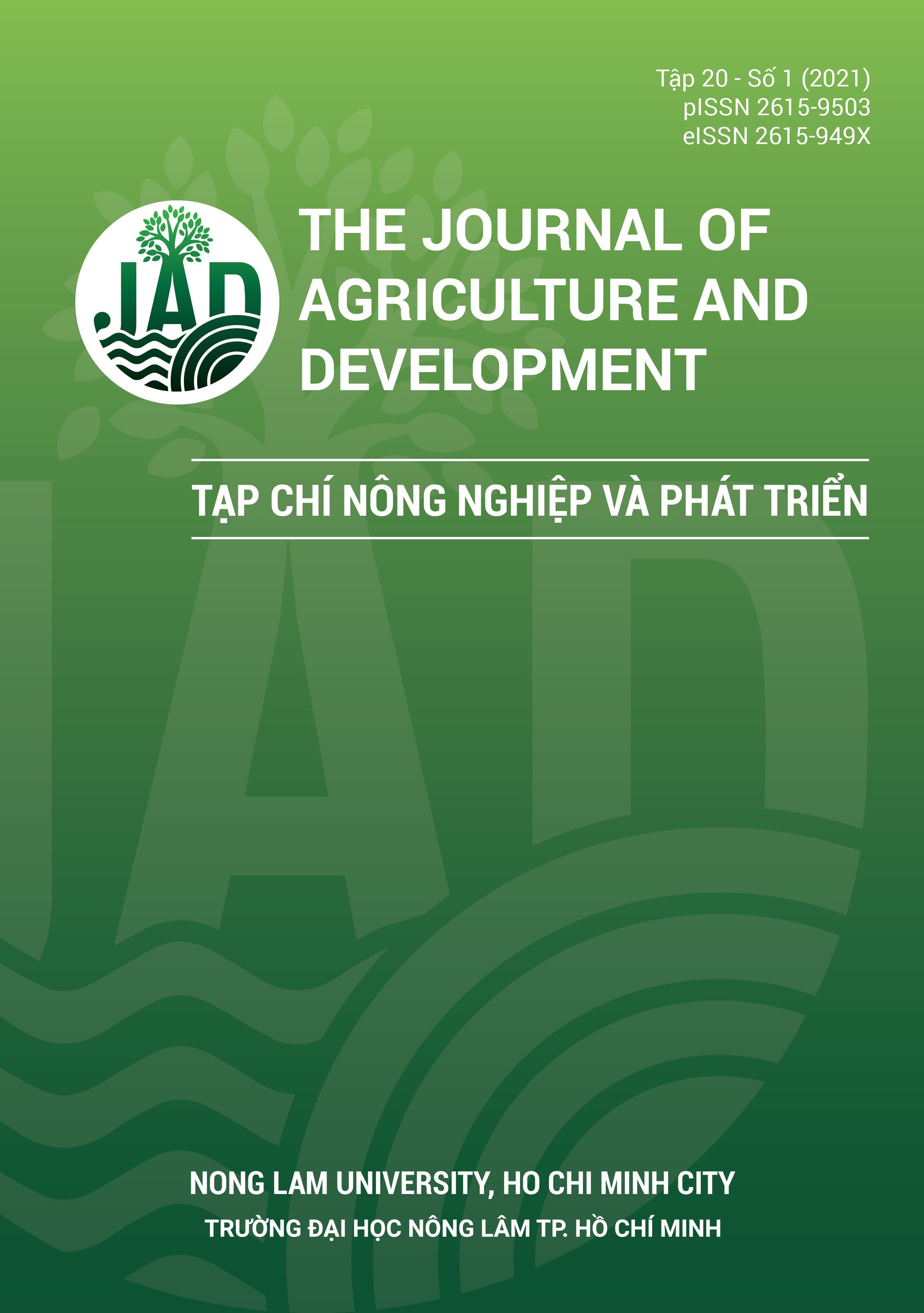Hiệu quả của Saccharomyces cerevisiae trong việc ức chế sản sinh aflatoxin và làm giảm tác hại của aflatoxin ở vịt con
Main Article Content
Tóm tắt
Từ các nguồn men bánh mì, đất, trái cây, 27 gốc nấm men Saccharomyces cerevisiae đã được thu nhận thông qua phân lập và định danh bằng kỹ thuật PCR. Định tính khả năn ức chế của các gốc S. cerevisiae phân lập được đối với sự sản sinh aflatoxin từ Aspergillus flavus trên môi trường nước cốt dừa. Kết quả ghi nhận phương pháp định tính trên môi trường nước cốt dừa có thể sử dụng làm phương pháp sàng lọc sơ bộ chủng S. cerevisiae có tác động ức chế đối với nấm mốc A. flavus sinh aflatoxin. Trên môi trường bắp xay, với tỷ lệ 104 bào tử nấm mốc A. flavus sinh aflatoxin và 108 tế bào nấm men S. cerevisiae/g bắp cho thấy S. cerevisiae có khả năng làm giảm lượng aflatoxin do A. flavus sinh ra trong bắp. Trong thử nghiệm trên vịt con 1 ngày tuổi, với thức ăn hỗn hợp được gây nhiễm 300 ppb aflatoxin và được trộn với 108 tế bào S. cerevisiae/kg thức ăn, đã làm giảm rõ rệt tác động của aflatoxin lên gan và thận của vịt con.
Article Details
Tài liệu tham khảo
Çelýk, K., Denlý, M., & Savas, T. (2003). Reduction of toxic effects of aflatoxin B1 by using baker yeast (Saccharomyces cerevisiae) in growing broiler chicks diets. Revista Brasileira de Zootecnia 32(3), 615-619.
Kusumaningtyas, E., Widiastuti, R., & Maryam R. (2006). Reduction of aflatoxin B1 in chicken feed by using Saccharomyces cerevisiae, Rhizopus oligosporus and their combination. Mycopathologia 162(4), 307-311. https://doi.org/10.1007/s11046-006-0047-4
Le, P. A. ( 2002). Effects of some substances capable of adsorbing Aflatoxin in super meat duck feeding diets (Unpublished Doctoral Dissertation). Nong Lam University, Ho Chi Minh City, Vietnam.
Matur, E., Ergul, E., Akyazi, I., Eraslan, E., & Cirakli, Z. T. (2010). The effects of Saccharomyces cerevisiae extract on the weight of some organs, liver, and pancreatic digestive enzyme activity in breeder hens fed diets contaminated with aflatoxins. Poultry Science 89(10), 2213-2220. https://doi.org/10.3382/ps.2010-00821
Nguyen, N. H. (2006). Bacillus subtilis possibly used for aflatoxin control. Proceedings of International workshop on Biotechnology in Agriculture (75-77). Ho Chi Minh City, Vietnam: Nong Lam University. 75-77.
Pinheiro, R. E. E., Rodrigues, A. M. D., Lima, C. E., Santos, J. T. O., Pereyra, C. M., Torres, A. M., Cavaglieri, L. R., Lopes, J. B., & Muratori, M. C. S. (2020). Saccharomyces cerevisiae as a probiotic agent and a possible aflatoxin B1 adsorbent in simulated fish intestinal tract conditions. Arquivo Brasileiro de Medicina Vet- erinária e Zootecnia 72(3), 862-870.
Pizzolitto, R. P., Armando, M. R., Salvano, M. A., Dalcero, A. M., & Rosa, C. A. (2013). Evaluation of Saccharomyces cerevisiae as an antiaflatoxicogenic. Poultry Science 92(6), 1655-1663. https://doi.org/10.3382/ps.2012-02846
Sabaté, J., Guillamon, J. M., & Cano, J. (2000). PCR differentiation of Saccharomyces cerevisiae from Saccharomyces bayanus/Saccharomyces pastorianus using specific primers. FEMS Microbiology Letters 193(2), 255-259. https://doi.org/10.1111/j.1574-6968.2000.tb09433.x
Stanley, V. G., Ojo, R., Woldesenbet, S., Hutchinson, D. H., & Kubena, L. F. (1993). The use of Saccharomyces cerevisiae to suppress the effects of aflatoxicosis in broiler chicks. Poultry Science 72(10), 1867-1872. https://doi.org/10.3382/ps.0721867
Zaghini, A., Martelli, G., Roncada, P., Simioli, M., & Rizzi, L. (2005). Mannanoligosaccharides and aflatoxin B1 in feed for laying hens: Effects on egg quality, aflatoxins B1 and M1 residues in eggs, and aflatoxin B1 levels in liver. Poultry Science 84(6), 825-832. https://doi.org/10.1093/ps/84.6.825








